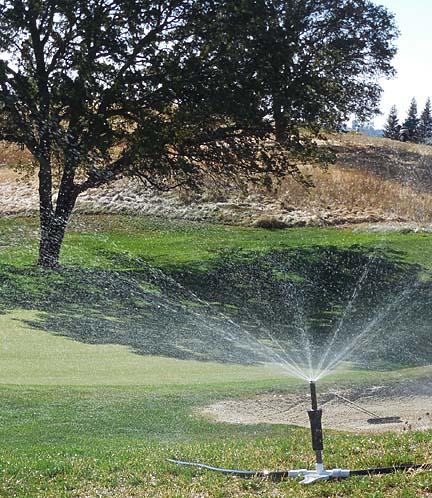 Like many assistants, Pat Smyth waited for years to get the call to become a head golf course superintendent. After six seasons waiting in the wings at Saddle Creek Resort in Copperopolis, California, Smyth was named the facility's head golf course superintendent on June 9. Two days later, the Calaveras County Water District informed him of mandatory water use reductions of 35 percent, proving that the old saying "be careful what you wish for ?" often is true.
Like many assistants, Pat Smyth waited for years to get the call to become a head golf course superintendent. After six seasons waiting in the wings at Saddle Creek Resort in Copperopolis, California, Smyth was named the facility's head golf course superintendent on June 9. Two days later, the Calaveras County Water District informed him of mandatory water use reductions of 35 percent, proving that the old saying "be careful what you wish for ?" often is true.After three years of drought, many golf courses throughout California already had adopted voluntary cutbacks and had redefined the meaning of dry and playable. Saddle Creek had cut back its water use by 10-15 percent in that time. With no end to the drought in sight, the 35 percent reduction couldn't have come at a more inopportune time.
"A lot of things went through my mind. I was expecting the worst," Smyth said. "The soils here are rocky already, and there is no water-holding capacity. The front nine greens were shutting down, and it was getting hot.
"You talk about stress, stress, stress. I had just gotten the job, and I was wondering whether I'd be able to keep it through the summer."
Rather than second-guess his career choice, or move in with his parents, Smyth got to work with the help of assistant Brandon Russell looking for ways to reduce water use. The result, he said, is a course that is faster and firmer than ever, it also is in the best condition it's been in since Smyth arrived there more than six years ago.
By diverting labor from detail work like edging bunkers to more needed chores like hand-watering hot spots and incorporating a 30-day surfactant program, low-flow sprinkler heads to irrigate rough areas, converting from full-circle rotors to part-circle and measuring results religiously with soil moisture monitors, Smyth has been able to cut average daily water use by 300,000 gallons.
Success for Smyth depended more on managing water more efficiently than it did cutting its use. Prior to the reduction mandate, it took three or four Saddle Creek maintenance workers all day every day to complete detail work, such as edging cart paths and along the edges of the property's 102 bunkers. That was a drain on a staff of seven full-time employees (including Smyth and his equipment manager) and six seasonal workers. With voluntary reductions of 10-15 percent already in place for the past three years, delivering water only to where it was needed most and ensuring it lasted as long as possible in the canopy and rootzone were critical components of a successful water-management plan.
The first step was educating club administration and golfing members about the cutbacks, what that would mean to the golf course and what Smyth and his crew could do to keep the course alive.
Adjuvants had been used for several years at Saddle Creek, but their use was limited mainly to greens and spot use on fairway trouble areas. This year, Smyth convinced the club to free up more funding for an expanded program to help keep the course alive. His new wetting agent program included applying Neptune, a polyglycol ether ester adjuvant from Loveland Products, on greens, tees and fairways at a rate of 2 gallons per acre.
The impact was noticeable almost immediately.
"It's helped tremendously," Smyth said. "I'm going to fight for that in the budget now every year."
Rather than waste time every day edging bunkers and cart paths, the crew now spends that time hand-watering to make sure every place that needs water gets it, and areas that do not need water don't get any.
"I went to the membership, the men's club, the ladies club and told them what this meant to us, and that edging was very labor intensive," he said. "I was able to convince them that we just couldn't do that anymore, and they allowed me to move our labor to hand-watering to keep the course alive.
"In order to keep course playable and as green as possible, we needed to implement a hand-watering program. Membership was OK with that, and the staff was happy to ignore the detail work."
A series of low-flow, pop-up sprinklers from Hunter that deliver water at a 1.3 gpm trickle now distribute water to areas where hand-watering isn't feasible. And 230 new Toro heads that deliver water in part-circle patterns replace some of the outdated 1,500 or so full-circle heads scattered around the course. That alone has accounted for a savings of 50,000 gallons of water per night.
Smyth and Russell now check soil-moisture readings throughout the course multiple times a day with handheld monitors and for a while were even coming back to the course at night to make sure everything was still alive.
In the end, both the course and its crew were capable of enduring hardships the likes of which Smyth could not imagine.
"I knew I could do the job, but I didn't know if I could under these conditions," he said. "Everyone goes into this stressed, nervous and scared. This opened my eyes and made me realize I can do this. It makes you stronger and makes you realize what you are capable of doing.
"This also opened the eyes of the staff and members and showed that we really can do this with a lot less water if we stay on top of it every day."


